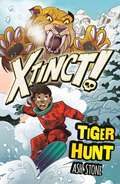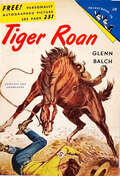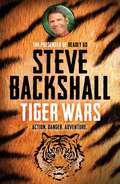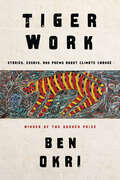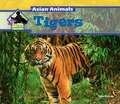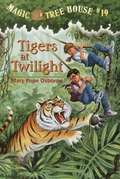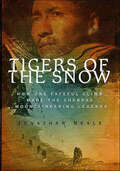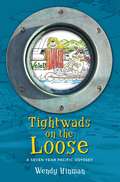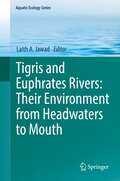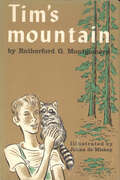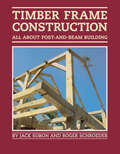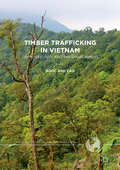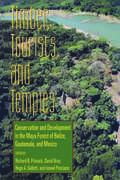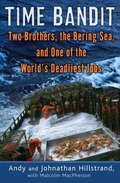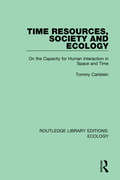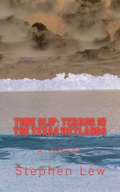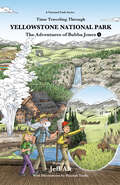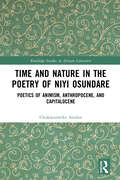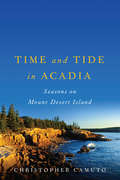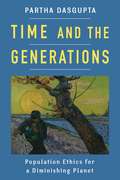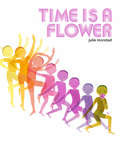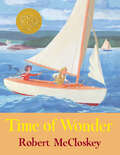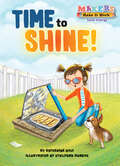- Table View
- List View
Tiger Hunt: Book 2 (Xtinct!)
by Ash StoneAfter Jeevan saved a T-Rex from dangerous hunters in the summer, he thinks his biggest adventure is behind him. Winter is here, and with it there's snowball fights and snowboarding races with his Neanderthal friend, Toe. It would be the perfect winter, if Barron Fox's new hunting lodge wasn't progressing so quickly, and if his mum wasn't so obsessed with recreating his earlier accident at the lab. When she tries to bring another harmless fossil of an extinct passenger pigeon back to life, she's sure nothing could go wrong... Perfect for fans of Beast Quest, Deadly 60 and Jurassic Park, these action-packed adventures will inspire readers to help save endangered species and combat extinction.
Tiger Roan
by Glenn BalchThis book relates the adventures of a young roan stallion in the wild, as a bucking horse in the rodeo, and as a saddle horse working with the only man he ever trusts. He meets people who are cruel and care about him only for making money, and one man who is kind and trustworthy, but who must leave him for a time. Will they find each other again?
Tiger Wars: Book 1 (The Falcon Chronicles #1)
by Steve BackshallAction, adventure, predators and peril - the bestselling first novel by BAFTA AWARD-winning DEADLY 60 TV presenter Steve Backshall. Deadly Adversaries. An Impossible Mission. Tiger Wars.Saker is on the run from the only life he knows. From India to the Himalayas and China he'll be pursued by hunting dogs, mercenaries, spies, thieves and assassins in his quest to set free the most majestic, lethal and valuable of all the predators - the tiger. With him, on every dangerous step of the adventure, is Sinter, a girl who has her own reasons for running away.Gripping adventure fiction perfect for fans of Anthony Horowitz and Charlie Higson. This is the first adventure in the Falcon Chronicles, filled with intrigue, adventure, exotic wildlife and dramatic locations. As Saker and Sinter rescue tigers or mountain gorillas, thwart shark finners and rainforest exploiters they come face to face with the world's most fascinating, majestic and lethal creatures.Steve Backshall is the hugely popular and fearless presenter of the BBC kids' series DEADLY 60 and LIVE AND DEADLY as well as star of BBC's Strictly Come Dancing 2014.
Tiger Work: Poems, Stories and Essays About Climate Change
by Ben OkriIn this poignant, timely collection, the renowned Booker Prize–winning author evokes the magic of nature and the urgency of protecting our environment.Twenty thousand years after a catastrophe wiped out the human race, visitors uncover their final messages scattered across the planet, in flooded cities and disintegrating books. These writings reveal the tragedies of people who continued to live as they always did—fearfully, selfishly—even as the end of their world loomed. These haunting stories within a story, together with a powerful selection of poems, fables, and essays, are a necessary reminder of the beauty of the earth and the importance of addressing the climate crisis with clarity, artistry, and passion.
Tigers (Asian Animals)
by Julie MurrayPresents information about tigers, including where they live, what they are like, how they behave, what they eat, how they raise young, and the things that threaten them as a species.
Tigers at Twilight (Magic Tree House #19)
by Mary Pope OsborneHaving used their magic tree house to travel to India, where they must get a gift to help free the dog Teddy from a spell, Jack and Annie have adventures involving a tiger and other endangered jungle animals.
Tigers of the Snow: How One Fateful Climb Made the Sherpas Mountaineering Legends
by Jonathan NealeTigers of the Snow is true story of the tragedy and survival on one of the world's most dangerous mountains.In 1922 Himalayan climbers were British gentlemen, and their Sherpa and Tibetan porters were "coolies," unskilled and inexperienced casual laborers. By 1953 Sherpa Tenzing Norgay stood on the summit of Everest, and the coolies had become the "Tigers of the Snow."Jonathan Neale's absorbing book is both a compelling history of the oft-forgotten heroes of mountaineering and a gripping account of the expedition that transformed the Sherpas into climbing legends. In 1934 a German-led team set off to climb the Himalayan peak of Nanga Parbat, the ninth highest mountain on earth. After a disastrous assault in 1895, no attempt had been made to conquer the mountain for thirty-nine years. The new Nazi government was determined to prove German physical superiority to the rest of the world. A heavily funded expedition was under pressure to deliver results. Like all climbers of the time, they did not really understand what altitude did to the human body. When a hurricane hit the leading party just short of the summit, the strongest German climbers headed down and left the weaker Germans and the Sherpas to die on the ridge. What happened in the next few days of death and fear changed forever how the Sherpa climbers thought of themselves. From that point on, they knew they were the decent and responsible people of the mountain.Jonathan Neale interviewed many old Sherpa men and women, including Ang Tsering, the last man off Nanga Parbat alive in 1934. Impeccably researched and superbly written, Tigers of the Snow is the compelling narrative of a climb gone wrong, set against the mountaineering history of the early twentieth century, the haunting background of German politics in the 1930s, and the hardship and passion of life in the Sherpa valleys.
Tightwads on the Loose: A Seven Year Pacific Odyssey
by Wendy HinmanEveryone dreams of tropical escape. But what happens when you escape for too long? Imagine spending 24 hours a day with your spouse in 31 not-so-square feet...for years; crossing the Pacific Ocean on two gallons of fuel; and tossing spaghetti marinara around your living room, then cleaning it up while bouncing like ice in a martini shaker. "Tightwads on the Loose" tells the story of Wendy and Garth, lured to sea by the promise of adventure. They buy a 31-foot boat that fit their budget better than it fits Garth's large frame and set sail for an open-ended voyage, never imagining they'd be gone seven years, or cover 34,000 miles at the pace of a fast walk. They live without what many would consider necessities and learn that teamwork and a sense of humor matter most as they face endless "character-building opportunities." They make a long-anticipated visit to the island where Garth had been shipwrecked as a teenager, only to find it had become a penal colony. An electronic catastrophe in the Solomon Islands leaves them without navigation equipment, which forces them to trade their free-wheeling lifestyle for one that seems straight out of a '60s sitcom: jobs at a U. S. Army base in the Marshall Islands. In Asia, they dodge typhoons and ships that threaten to turn their home into kindling. Finally they endure a grueling 49-day nonstop ocean crossing. But none of this prepares them for their arrival "home" to a post-9/11 America which leaves them wondering what had changed more, them or the world.
Tigress
by Helen CowcherAuthor Helen Cowcher addresses environmental concerns in this children's book. A tiger and her cubs leave their forest sanctuary to hunt. What will happen when they unknowingly attack a farmer's bull?
Tigris and Euphrates Rivers: Their Environment from Headwaters to Mouth (Aquatic Ecology Series #11)
by Laith A. JawadThe system of the Tigris-Euphrates Rivers is one of the great river systems of southwestern Asia. It comprises the Tigris and Euphrates Rivers, which follow roughly parallel courses through the heart of the Middle East. The lower portion of the region that they run through is known as Mesopotamia, was one of the cradles of civilisation. There are several environmental factors that govern the nature of the two rivers and shape the landscape the two rivers running through. Geological events create rivers, climate monitor the water supply, the surrounding land influences the vegetation and the physical and chemical features of water. The Tigris-Euphrates system runs through the territory of four countries, Iraq, Iran, Turkey and Syria. Therefore, any scientific approach to the environment of these two rivers should include the natural history events in these countries. The book "Tigris and Euphrates Rivers: Their Environment from Headwaters to Mouth" will be divided into nine parts. These parts deal with the issues of the environment, the status of the flora and fauna, the abiotic aspects, ecology, hydrological regime of the two rivers, the biotic aspects. Water resources, stress of the environment, conservation issues. Since the book of Julian Rzoska "Euphrates and Tigris Mesopotamian Ecology and Destiny" in 1980, no book or major reference has been published that includes between its cover the facts and information that the present book will present. Therefore, the importance of the present book falls in stating the present status of the environment of the two rivers and the comparison of their environment between now and that of 37 years ago as given by J. Rzoska (1980). The recent studies showed that there are a large number of natural and political events that happened within the last three decades in the area of the Tigris-Euphrates river system that for sure have done a great change to the environment of the two rivers and consequently changing the biological and non-biological resources of the two rivers. This book will be a reference book to both Academic and students across the Middle East in different disciplines of knowledge to use in their researches on Tigris-Euphrates river system. The scholars interested in this area will use this book as a guide to compare this freshwater system with other areas in Asia and the world.
Tim's Mountain
by Rutherford MontgomeryLittle Tim and Big Tim agreed that their shack high on the slopes of the Santa Cruz Mountains in California was the finest place in the world to live. Big Tim liked the easy living the woods provided, and Little Tim loved to roam the mountain meadows and thickets, learning the ways of the wild creatures—shy blacktail deer; crafty cougars; smart, fun-loving spotted skunks; and rapier-taloned hawks —who lived there. But the two Tims disagreed about Nubbin, the baby raccoon Little Tim found in a tree stump and brought home for a pet. To Big Tim, Nubbin was just another critter for the pot, or possibly a chance to earn a little cash money to buy a pig. He couldn’t understand Little Tim’s feeling for his clever pet, and secretly he thought the boy was sort of chicken-hearted. So when he sold the raccoon as a lure for Katy Drew’s hunting party, neither he nor anyone else on the mountain was prepared for Little Tim’s fury or for the bold action he took to retrieve his pet.
Timber Frame Construction: All About Post-and-Beam Building
by Jack A. Sobon Roger SchroederDiscover the satisfaction of making your own durable, economical, and environmentally friendly timber frame structures. Covering all aspects of timber frame construction, this practical guide is filled with easy-to-understand instructions, clear illustrations, and helpful photographs. With expert advice on selecting appropriate timber, necessary tools, safety considerations, joinery techniques, assembly, and raising, Jack Sobon and Roger Schroeder encourage beginners by offering complete plans for a small toolshed. Turn your dream of a timber frame house into a reality.
Timber Trafficking in Vietnam: Crime, Security and the Environment (Palgrave Studies in Green Criminology)
by Ngoc Anh CaoThis book is the first systematic investigation into the problem of timber trafficking in Vietnam, providing a detailed understanding of the typology of, victimization from, and key factors driving this crime. The book first reveals a multifaceted pattern of timber trafficking in Vietnam, comprising five different components: harvesting, transporting, trading, supporting, and processing. It then assesses the crime’s victimization from timber trafficking. Thanks to the employment of a broad conceptual framework of human security, Cao reveals that timber trafficking has substantial harmful impacts on all seven elements of human security: economic, food, health, environmental, personal, community, and political; whilst being closely interconnected, they vary between different groups of victims. Cao concludes by offering five solutions to better control of timber trafficking in the context of Vietnam, which crucially involve refining the current policy framework of forest governance and improving the efficiency of law enforcement. A wide-ranging and timely study, this book will hold particular appeal for scholars of green criminology and environmental harm.
Timber, Tourists, and Temples: Conservation And Development In The Maya Forest Of Belize Guatemala And Mexico
by Richard B. Primack Ismael Ponciano David Bray Hugo A. GallettiStretching across southern Mexico, northern Guatemala, and Belize, the Maya Forest, or Selva Maya, constitutes one of the last large blocks of tropical forest remaining in North and Central America. Home to Mayan-speaking people for more than 5,000 years, the region is also uncommonly rich in cultural and archaeological resources.Timber, Tourists, and Temples brings together the leading biologists, social scientists, and conservationists working in the region to present in a single volume information on the intricate social and political issues, and the complex scientifc and management problems to be resolved there. Following an introductory chapter that presents GIS and remote sensing data, the book: considers perspectives on managing forest resources and the forestry and conservation policies of each nation examines efforts by communities to manage their forest resources explains the connections between resource conservation and use by local people highlights research projects that integrate baseline biological research with impact assessments explains the need to involve local people in conservation effortTimber, Tourists, and Temples explores methods of supporting the biological foundation of the Maya Forest and keeping alive that unique and diverse ecosystem. While many areas face similar development pressures, few have been studied as much or for as long as the Maya Forest. The wealth of information included in this pathbreaking work will be valuable not only for researchers involved with the Maya Forest but for anyone concerned with the protection, use, and management of tropical forest ecosystems throughout the world.
Time Bandit: Two Brothers, the Bering Sea, and One of the World's Deadliest Jobs (Playaway Adult Nonfiction Ser.)
by Malcolm Macpherson Johnathan Hillstrand Andy HillstrandThe story of two brothers, Johnathan and Andy Hillstrand, who are maverick fisherman on the Bering Sea. They share the skippering duties on board their family-operated vessel, the Time Bandit. They are totally outrageous characters, taking on what is known to be the most dangerous job in the world. The Bering Sea is dangerous and mercurial and can steal years from a fisherman's life and Time Bandit is the name of the fishing vessel the brothers use to hook the Alaskan King Crabs. In pursuit of their daily catch, the brothers brave ice floes and heaving waves 60ft high, the perils of 1000lb steel crab traps thrown about by the wind and the constant menace of open water. The details of their childhood make you wonder how they ever lived past the age of ten! This amazing story, co-written with Malcolm MacPherson, brings to life the heart-in-your-throat existence of the Hillstrand brothers.
Time Resources, Society and Ecology: On the Capacity for Human Interaction in Space and Time (Routledge Library Editions: Ecology #1)
by Tommy CarlsteinOriginally published in 1982, Time Resources, Society and Ecology examines and seeks to examine the time dimension in terms of the ecology, technology, social organization and spatial structure of the human habitat. Approaches to time resources – sociological time-budget studies, anthropological activity analysis, and economic analysis of money allocation – have been limited by their sectoral scope or their failure to relate effectively to the processes of social interaction, technological change and environmental structure. In this book, the book’s articulation of time resources is developed in a general theoretical framework of action and interaction in time and space. The book examines constraints and possibilities facing preindustrial societies and throws light on the impact of technology on modern societies. Basic models of time allocation are presented, and, finally, a cross-cultural comparison is made of the mobilization of time resources in preindustrial societies. Geographers, social anthropologists and human ecologists should find this work directly relevant to their interest in understanding the interactions between man and environment.
Time Slip: Terror in the Texas Wetlands
by Stephen D. LewFour Texas teens stumble upon a living nightmare when an electrical storm creates a time portal. The group unintentionally journeys 158 years back in time where they are held captive by a band of Karankawa Indians. On the desolate Texas wetlands, the mismatched teens must confront their inner-demons, survive the hostile environment, and find a way to work together to get back home.
Time Traveling Through Yellowstone National Park: The Adventures of Bubba Jones (#5) (A National Park Series #5)
by Jeff Alt Hannah TuohyIn the fifth book of this award-winning national park series, Tommy “Bubba Jones” and his sister, Jenny “Hug-A-Bug,” uncover amazing facts about Yellowstone National Park while on a mission to solve a park mystery. This is no ordinary brother and sister duo; they are part of a legendary time travel family with a mission to preserve and protect our national parks and they have developed a reputation for solving mysteries. As they time travel back hundreds, thousands, and millions of years, they not only learn about the past but also experience it. They encounter wild creatures and ancient plants. They meet members of the early park expeditions and encounter the U.S. Army who once served as the park stewards. They learn about the Native Americans that call this land home. They learn all about the volcanic activity and unravel some of the park's secrets. Discover Yellowstone National Park in a whole new way.
Time and Nature in the Poetry of Niyi Osundare: Poetics of Animism, Anthropocene, and Capitalocene (Routledge Studies in African Literature)
by Chukwunwike AnolueThis book provides an ecocritical analysis of the poetry of the famous Nigerian poet Niyi Osundare. It interrogates the intricate interface between time and nature in 11 of Osundare’s defining poetry collections. This is a book of postcolonial ecocriticism from an African perspective. It brings together the ecocritical theory of animism and theories of geologic time in the discussion of Osundare’s poetry. Osundare shows that animism has a lot to offer in enriching human understanding of the ecosystem. And while he eloquently catalogues problems undermining the health of the earth in this age of the Anthropocene and the Capitalocene in his poetry, he also holds on to the hope of a better future. The book concludes that Osundare’s optimism is what informs his use of poetry to press humankind to rise to the duty of salvaging the environment. Deploying an interdisciplinary approach that stretches across the fields of literature, religion, geology, physics, economics, and anthropology, this book will be an important read for those looking for fresh ways to understand Osundare’s poetry and African nature writing.
Time and Tide in Acadia: Seasons on Mount Desert Island
by Christopher CamutoCamuto delivers insights on Mount Desert Island, a place of stunning beauty and natural wonders. Mount Desert Island and Acadia National Park have been described as the climax of the coast of Maine. Millions are drawn every year to the stunning beauty of this rocky landscape of spruce-fir forest and granite islands. Some, like nature writer Christopher Camuto, never stop coming back. In Time and Tide in Acadia the author draws on years of walking Mount Desert's summits and shorelines, canoeing its marshes, kayaking its tidal waters, and visiting its outer islands. To this task Camuto brings an appetite for observing wildlife and landscape with considerable originality, a regard for history and indigenous perceptions of nature, a keen interest in exploring the psychological and philosophical appeal of nature, and a writer's love of language. As in his previous, highly praised books, Camuto fulfills his promise to give the reader innumerable vantages on the nature of a remarkable place that it takes time to get to know.
Time and the Generations: Population Ethics for a Diminishing Planet (Kenneth J. Arrow Lecture Series)
by Partha DasguptaHow should we evaluate the ethics of procreation, especially the environmental consequences of reproductive decisions on future generations, in a resource-constrained world? While demographers, moral philosophers, and environmental scientists have separately discussed the implications of population size for sustainability, no one has attempted to synthesize the concerns and values of these approaches. The culmination of a half century of engagement with population ethics, Partha Dasgupta’s masterful Time and the Generations blends economics, philosophy, and ecology to offer an original lens on the difficult topic of optimum global population.After offering careful attention to global inequality and the imbalance of power between men and women, Dasgupta provides tentative answers to two fundamental questions: What level of economic activity can our planet support over the long run, and what does the answer say about optimum population numbers? He develops a population ethics that can be used to evaluate our choices and guide our sense of a sustainable global population and living standards. Structured around a central essay from Dasgupta, the book also features a foreword from Robert Solow; correspondence with Kenneth Arrow; incisive commentaries from Joseph Stiglitz, Eric Maskin, and Scott Barrett; an extended response by the author to them; and a joint paper with Aisha Dasgupta on inequalities in reproductive decisions and the idea of reproductive rights. Taken together, Time and the Generations represents a fascinating dialogue between world-renowned economists on a central issue of our time.
Time for Magic: A Shamanarchist's Guide to the Wheel of the Year
by Philip Carr-Gomm John Marchant Jamie Reid Stephen EllcockPunk meets Druidry in the only trade edition of Jamie Reid's art, weaving c.180 radical art images into the structure of the pagan Wheel of the Year. The art is selected and introduced by curator Stephen Ellcock with notes on the seasonal celebrations by former Chief Druid of OBOD Philip Carr-Gomm.Time for Magic offers an entrancing overview of Jamie Reid&’s incredible art, structured around the eight seasonal festivals of the Wheel of the Year (the equinoxes and solstices plus Imbolc, Beltane, Lughnasadh and Samhain). Jamie observed these festivals, holding rituals at his allotment in Liverpool, and focused on this theme in his later paintings. This book features key Wheel of the Year artworks as well as famous earlier pieces, including the pre-punk, Situationist-inspired agit-prop and the work he produced for the Sex Pistols. Curator Stephen Ellcock has selected the art and in his own inimitable creative style arranged it into season-themed chapters, as well as finding images of Druidic ceremonies held by Jamie&’s great-uncle, Chief Druid George Watson MacGregor Reid.Stephen Ellcock in conversation with John Marchant introduces Jamie&’s life, legacy and love of making trouble; John Marchant provides captions giving deep insight in Jamie&’s work; and Philip Carr-Gomm writes about the Wheel of the Year and how it can help us find a new way of being in this era of climate crisis.
Time is a Flower
by Julie MorstadA playful and poignant exploration of the nature of time through the eyes of a child from acclaimed author/illustrator Julie Morstad.What is time? Is it the tick tick tock of a clock, numbers and words on a calendar? It's that, but so much more. Time is a seed waiting to grow, a flower blooming, a sunbeam moving across a room. Time is slow like a spider spinning her web or fast like a wave at the beach. Time is a wiggly tooth, or waiting for the school bell to ring, or reading a story . . . or three! But time is also morning for some and night for others, a fading sunset and a memory captured in a photo taken long ago.In this magical meditation on the nature of time, Julie Morstad shines a joyful light on a difficult-to-grasp concept for young readers and reminds older readers to see the wonders of our world, including children themselves, through the lens of time.
Time of Wonder (Picture Puffins Ser.)
by Robert McCloskeyWinner of the Caldecott Medal! For fans of Blueberries for Sal, One Morning in Maine, and Make way for Ducklings."Out on the islands that poke their rocky shores above the waters of Penobscot Bay, you can watch the time of the world go by, from minute to minute, hour to hour, from day to day . . ." So begins this classic story of one summer on a Maine island from the author of One Morning in Maine and Blueberries for Sal. The spell of rain, the gulls and a foggy morning, the excitement of sailing, the quiet of the night, the sudden terror of a hurricane, and, in the end, the peace of the island as the family packs up to leave are shown in poetic language and vibrant, evocative pictures.
Time to Shine! (Makers Make It Work)
by Catherine DalyBoom! Thunder crashes, and the electricity goes out. Sammi is crushed. Her parents had a fancy dinner planned! But no lights doesn't mean no power. Can Sammi use sun power to save the day? Tying into the popular Makers Movement, Makers Make It Work is a series of fun easy-to-read stories that focus on problem-solving and hands-on action. This charming story explores the Makers theme of Engineering and includes explanatory sidebars and a catapult activity for young makers to try themselves!
